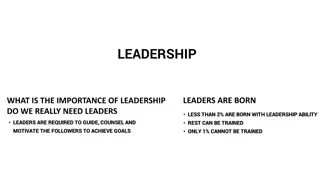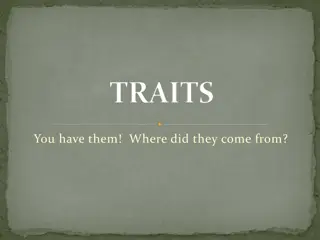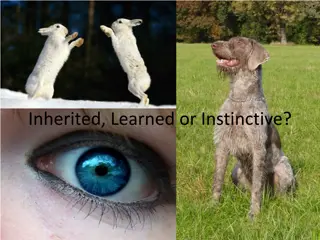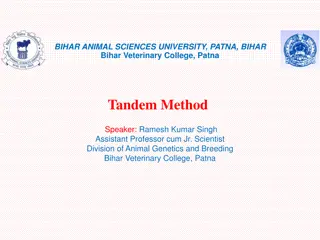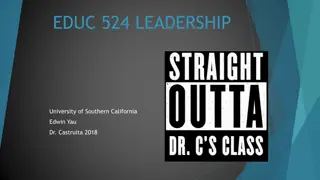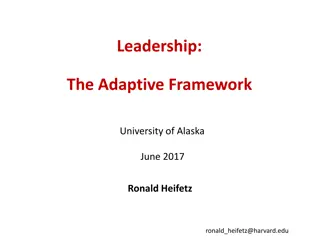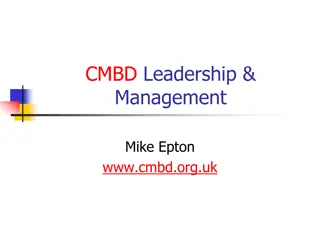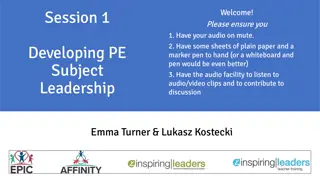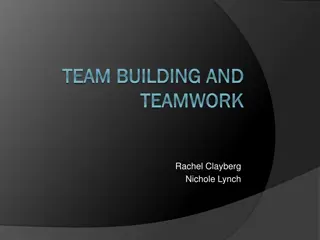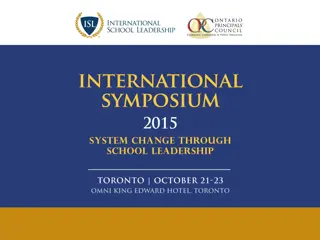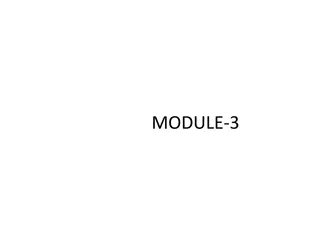Leadership Insights: Traits, Differences, and Framework
Leadership involves guiding others towards shared goals through vision, inspiration, knowledge, and resilience. It distinguishes from management in focus and approach. Analyzing leadership involves assessing leader traits, situational factors, and follower dynamics. The leadership framework comprises leader traits, follower values, and situational dynamics. Different leadership styles like transactional and transformational emphasize rewarding performance and inspiring change, respectively.
Download Presentation

Please find below an Image/Link to download the presentation.
The content on the website is provided AS IS for your information and personal use only. It may not be sold, licensed, or shared on other websites without obtaining consent from the author. Download presentation by click this link. If you encounter any issues during the download, it is possible that the publisher has removed the file from their server.
E N D
Presentation Transcript
LEADERSHIP LEADERSHIP MODULE 5 Prepared By Asst.Prof Sreeti Gangadharan
LEADERSHIP Leadership is the ability to lead or guide people towards the accomplishment of a common goal. It involves: Having a vision Convincing others by sharing the vision. Inspiring others to realize the vision. Providing knowledge and strategy. Coordinating and guiding. Balancing interests of all. Being resilient at times of crisis. 1. 2. 3. 4. 5. 6. 7.
LEADER AND A BOSS: All bosses are not leaders. Leaders lead people by their influence and charisma rather than authority. A boss may or may not be a leader.
LEADERSHIP AND MANAGEMENT: Management is doing things right while leadership is doing right things. Management is concerned with planning and execution, where as leader is more concerned with setting the direction. Manager looks at how and when? Leader at what and why? Management relies at organizational structure while leader relies on personal influence. Manager motivates- leader inspires. Management focuses on maintenance leader focuses on development. Manager coordinates people, leader nurtures them.
ANALYZING LEADERSHIP: LEADER Personality Position Expertise SITUATION Task Stress Environment FOLLOWERS Cohesiveness Values Norms
Leadership Framework consists of three elements: LEADER 1. The traits of a leader, his expertise and his societal/ organizational positions are the key factors. 2. FOLLOWERS The values the norms and extend of bond between the leaders and followers influence how a group performs. 3. SITUATION The interaction between the leader and the followers depends on the situation.
TRANSACTIONAL LEADERSHIP: It is a type of leadership where leader maintains a relation with the followers through a series of transactions involving rewards and punishments. Employers are rewarded for good performance and punished for poor performance. The leader relies on his position and authority to get things done.
TRANSFORMATIONAL LEADERSHIP: Kind of leadership where leader transforms thinking of the followers by giving them a sense of mission and excitement. The leader relies on his/her charisma and energy rather than authority. The leader encourages to take risks try new strategies and be creative.
Main features of Transactional leadership: 1. CONTINGENT REWARD: Involves exchange of rewards for effort Promotion for good performance. 2. MANAGEMENT BY EXCEPTION: Maintaining the situation rather than going for changes. The manager involves only when required.
Main features of Transformational leadership: 1. INSPIRING VISION Focus on bigger picture and communicate expectations. Vision mission and goals of organisation are expressed in simple and inspiring terms. 2. INTELLECTUAL STIMULATION Leader tries to bring out the best. 3. INDIVIDUAL CONECRN Leader appreciates the differences between individual employers and treats each one accordingly. Gives personal attention to each employee.
Transformational Leadership Transactional leadership Suited for troubled times where innovation and change is required. Appeals to emotions of the followers. It is informal and charismatic. More than one leader. Stimulates and challenges mostly to promote innovation. Employs influence and intellectual stimulation using charisma and enthusiasm. Is proactive. Suited for settled environment- through accepted practices. Where emotional level is not high It is formal and bureaucratic. There is only one leader. Employs planning and execution to maintain status quo. Gives rewards and punishment using authority. Is reactive
LEADERSHIP TRAITS: Openness to experience Conscientiousness Extroversion Agreeableness Neuroticism
TRAITS FOUND IN LEADERS: Influence- ability to see bigger picture, charisma, enthusiasm, initiative. Results- strategic thinking, intelligence, risk taking Control- self assuredness, dominance, stability Support- sensitivity to others, integrity, open mindedness.
SIX STYLES OF LEADERSHIP: According to Daniel Coleman, there are six styles of leadership. Authoritative style 1. Affiliative style 2. Coaching style 3. Coercive style 4. Democratic style 5. Pace setting style 6.
VUCA LEADERSHIP VUCA is an acronym for: V- Volatility U- Uncertainty C- Complexity A- Ambiguity VUCA was coined by the US army to describe the world aftermath of Cold War.
Leaders need these qualities in a VUCA world: Learning Agility Intellect to deal with complexity Values for guidance through uncertainty Emotions to relate to others Drive for relentless pursuit of goals
LEARNING AGILITY: Learning agility is the ability of oneself to learn from new experiences and learn from various situations with speed, collaboration. flexibility and Being open to new experiences. Integrate new perspectives and skills into ones life.
Agile learning involves: Welcoming diverse experiences Thinking to make sense out of them. Being flexible and adapting on the go Preparing better by learning
Traditional learning Agile learning IQ is important EQ is given importance Opening to diverse experiences Generating solutions to problems Getting new perspectives Technical skills Traditional management skills Conceptual thinking Reflecting on why and how Analytical and data crunching skills
TURNAROUND LEADERSHIP: It is a fast and dramatic change for better performance of an organisation. Leaders or executives who are assigned with this task are referred as turn around leaders Time is the key factor in turn around leadership
Qualities of a turn around leader: Ability to analyse data and identify critical points. Ability to negotiate and convince Ability to take fast decisions Ability to gain respect Ability to sense an urgency Willingness to neglect resistance Willingness to lead Ability to take quick decisive action
Strategies for turnaround leadership: Collect and analyse data Identify problem areas Make an action plan Communicate problems, solutions and need for urgency Project an optimistic view Change some of top Management if necessary Ensure control over all managerial and financial transactions Do away with low performing assets Focus on some early wins to silence critics Challenge norms that inhibit success Measure progress frequently Solve problems as soon as they come up
FIVE LEVELS OF LEADERSHIP: Pinnacle People development Production Permission Position
POSITION: Lowest level Leader uses his power and influence using his hierarchical rank. Such leaders depend on authority, rules and control, to get things done. Subordinates are not motivated by anything but only by self interest.
PERMISSION: This level depends on relationships. Leader opens up channels of communication. Instead of relying on authority he empathizes people, builds trust and values contribution of each individual. He genuinely likes his teammates. Nurtures a sense of belongingness. People obey and follow him because they want to and not because they have to. Makes work environment positive.
PRODUCTION: Trying to make things happen. A production level leader gets results and respect Will try to materialize the vision and create solutions further. Make system efficient Plays the role of an agent of change
PEOPLE DEVELOPMENT Mature and far sighted leaders think beyond the present. They create new leaders. They focus on inspiring people to rise up to their true potential and hence influence their lives. It is about identifying leadership material, finding out niche areas, empowering, showing by example, teaching and believing. Leaders, in a way reproduce themselves.
PINNACLE: Highest level in the evolution of a leader. The leader creates a legacy. He becomes an icon. People will follow him because he represents what he says. He will remain humble and authentic yet complete his mission with best results. Some are naturally gifted with this level quality.
LEADERSHIP GRID: Leadership behavioral leadership model developed by Blake and Mouton. It categorizes leaders into 81 possible types: grid or managerial grid is a 1. Concern for people: Degree to which the leader is oriented towards developing relationships and caring for team members rather than getting results 2. Concern for production: leader is oriented towards getting results and improving productivity rather than being concerned about the employees.
IMPOVERISHED LEADERSHIP STYLE: They have low concern for both production as well as people. They remain indifferent towards organizational goals and also towards employees. They will not take responsibilities, avoid facing problems and prefer low visibility. They will be concerned only with preserving their own positions. This type of leadership results in dissatisfaction among employees, inefficiency and disharmony.
COUNTRY CLUB LEADERSHIP STYLE: It gives maximum emphasis to the comfort and feelings of the employees. It takes care of the needs of the employees. Leader would like to be liked by the employees even if the production is less. It results in a friendly team and harmonious work place. But also results in inefficiency and low productivity
PRODUCE AND PERISH LEADERSHIP STYLE: High emphasis on production and low concern for people. The leader dictates, dominates and treats employers as expendable resources. People can become indifferent and rebellious. It results in short lived performance and productivity. Low employee morale and high conflict levels.
MIDDLE OF THE ROAD LEADERSHIP STYLE It compromises between productivity and concern for people and tries to strike a balance between the two. Leaders often go along with the majority and choose decision that is popular. It results in mediocre performance and also discontent among employees. It lacks drive for excellence and new challenges. There is no sense of achievement.
TEAM LEADERSHIP STYLE: It is the most effective style that utilises best of both worlds. It is also called as sound leadership style. Leaders are committed to the goals of the organisation and concerned about needs of their team. They believe in team work, pleasant and harmonious team work. It results in greater motivation, challenge and maintains a cordial atmosphere. High level of satisfaction and efficiency and production.
Elements associated to leadership grid theory : Initiative 1. Inquiry 2. Advocacy 3. Decision making 4. Conflict resolutions 5. Critique 6. Resilience 7.
EFFECTIVE LEADERSHIP: Dominance Conscientiousness Social tendency Internal locus of control



